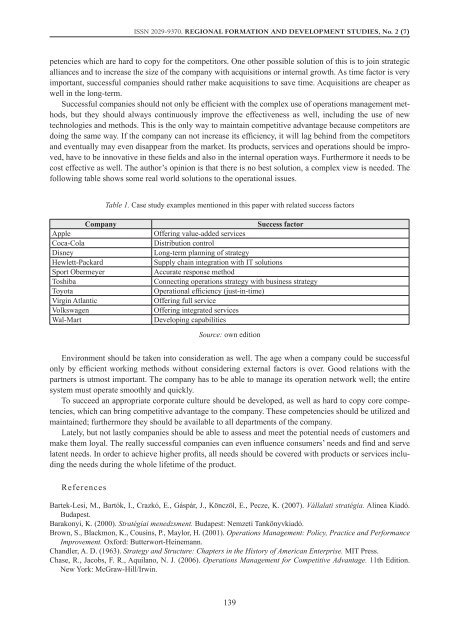regional formation and development studies - KlaipÄdos universitetas
regional formation and development studies - KlaipÄdos universitetas
regional formation and development studies - KlaipÄdos universitetas
Create successful ePaper yourself
Turn your PDF publications into a flip-book with our unique Google optimized e-Paper software.
ISSN 2029-9370. Regional Formation <strong>and</strong> Development Studies, No. 2 (7)<br />
petencies which are hard to copy for the competitors. One other possible solution of this is to join strategic<br />
alliances <strong>and</strong> to increase the size of the company with acquisitions or internal growth. As time factor is very<br />
important, successful companies should rather make acquisitions to save time. Acquisitions are cheaper as<br />
well in the long-term.<br />
Successful companies should not only be efficient with the complex use of operations management methods,<br />
but they should always continuously improve the effectiveness as well, including the use of new<br />
technologies <strong>and</strong> methods. This is the only way to maintain competitive advantage because competitors are<br />
doing the same way. If the company can not increase its efficiency, it will lag behind from the competitors<br />
<strong>and</strong> eventually may even disappear from the market. Its products, services <strong>and</strong> operations should be improved,<br />
have to be innovative in these fields <strong>and</strong> also in the internal operation ways. Furthermore it needs to be<br />
cost effective as well. The author’s opinion is that there is no best solution, a complex view is needed. The<br />
following table shows some real world solutions to the operational issues.<br />
Table 1. Case study examples mentioned in this paper with related success factors<br />
Company<br />
Apple<br />
Coca-Cola<br />
Disney<br />
Hewlett-Packard<br />
Sport Obermeyer<br />
Toshiba<br />
Toyota<br />
Virgin Atlantic<br />
Volkswagen<br />
Wal-Mart<br />
Success factor<br />
Offering value-added services<br />
Distribution control<br />
Long-term planning of strategy<br />
Supply chain integration with IT solutions<br />
Accurate response method<br />
Connecting operations strategy with business strategy<br />
Operational efficiency (just-in-time)<br />
Offering full service<br />
Offering integrated services<br />
Developing capabilities<br />
Source: own edition<br />
Environment should be taken into consideration as well. The age when a company could be successful<br />
only by efficient working methods without considering external factors is over. Good relations with the<br />
partners is utmost important. The company has to be able to manage its operation network well; the entire<br />
system must operate smoothly <strong>and</strong> quickly.<br />
To succeed an appropriate corporate culture should be developed, as well as hard to copy core competencies,<br />
which can bring competitive advantage to the company. These competencies should be utilized <strong>and</strong><br />
maintained; furthermore they should be available to all departments of the company.<br />
Lately, but not lastly companies should be able to assess <strong>and</strong> meet the potential needs of customers <strong>and</strong><br />
make them loyal. The really successful companies can even influence consumers’ needs <strong>and</strong> find <strong>and</strong> serve<br />
latent needs. In order to achieve higher profits, all needs should be covered with products or services including<br />
the needs during the whole lifetime of the product.<br />
References<br />
Bartek-Lesi, M., Bartók, I., Crazkó, E., Gáspár, J., Könczöl, E., Pecze, K. (2007). Vállalati stratégia. Alinea Kiadó.<br />
Budapest.<br />
Barakonyi, K. (2000). Stratégiai menedzsment. Budapest: Nemzeti Tankönyvkiadó.<br />
Brown, S., Blackmon, K., Cousins, P., Maylor, H. (2001). Operations Management: Policy, Practice <strong>and</strong> Performance<br />
Improvement. Oxford: Butterwort-Heinemann.<br />
Ch<strong>and</strong>ler, A. D. (1963). Strategy <strong>and</strong> Structure: Chapters in the History of American Enterprise. MIT Press.<br />
Chase, R., Jacobs, F. R., Aquilano, N. J. (2006). Operations Management for Competitive Advantage. 11th Edition.<br />
New York: McGraw-Hill/Irwin.<br />
139

















